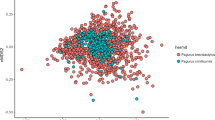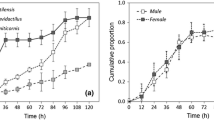Abstract
Pagurus longicarpus hermit crabs depend on empty gastropod shells for protection against predation. Hermit crabs avoid gastropod shells in which holes have been drilled by naticid gastropods, and hermit crabs forced to occupy drilled shells are more vulnerable to predation by green crabs, Carcinus maenas. In this study, we examined the effect of predator cues on P. longicarpus shell investigation behavior and shell choice. In paired laboratory shell choice trials, we examined hermit crab response to green crab chemical cues. We compared hermit crabs from two sites differing in the percentage of Littorina littorea shells with drill holes. The percentage of time hermit crabs spent occupying intact shells increased significantly in the presence of predator cues. The effect of predator cues on the amount of time hermit crabs spent investigating shells differed between individuals from the two sites. Predator effluent had a marginal effect on the proportion of hermit crabs initially choosing intact shells and within 15 min most hermit crabs in both treatments occupied intact shells due to shell switching. These results indicate that predation cues alter P. longicarpus shell choice behavior favoring intact shells, which provide greater protection. In summary, predation appears to be a key factor influencing hermit crab shell selection behavior.


Similar content being viewed by others
References
Angel JE (2000) Effects of shell fit on the biology of the hermit crab Pagurus longicarpus (Say). J Exp Mar Biol Ecol 243:169–184
Benvenuto C, Gherardi F (2001) Population structure and shell use in the hermit crab, Clibanarius erythropus: a comparison between Mediterranean and Atlantic shores. J Mar Biol Assoc UK 81:77–84
Bertness MD (1981) Predation, physical stress, and the organization of a tropical rocky intertidal hermit crab community. Ecology 62:411–425
Bertness MD, Cunningham CW (1981) Crab shell-crushing predation and gastropod architectural defense. J Exp Mar Biol Ecol 50:213–230
Blackstone NW (1985) The effects of shell size and shape on growth and form in the hermit crab Pagurus longicarpus. Biol Bull 168:75–90
Brodie R (1999) Ontogeny of shell-related behaviors and transition to land in the terrestrial hermit crab Coenobita compressus H. Milne Edwards. J Exp Mar Biol Ecol 241:67–80
Brooks WR, Mariscal RN (1985) Shell entry and shell selection of hydroid-colonized shells by three species of hermit crabs from the northern Gulf of Mexico. Biol Bull 168:1–17
Carlon DB, Ebersole JP (1995) Life-history variation among three temperate hermit crabs: the importance of size in reproductive strategies. Biol Bull 188:329–337
Conover MR (1978) The importance of various shell characteristics to the shell-selection behavior of hermit crabs. J Exp Mar Biol Ecol 32:131–142
Cote IM, Reverdy B, Cooke PK (1998) Less choosy or different preference? Impact of hypoxia on hermit crab shell assessment and selection. Anim Behav 56:867–873
Elner RW (1981) Diet of green crab Carcinus maenas (L.) from Port Herbert, southwestern Nova Scotia. J Shellfish Res 1:89–94
Elwood RW (1995) Motivational change during resource assessment by hermit crabs. J Exp Mar Biol Ecol 193:41–55
Elwood RW, Briffa M (2001) Information gathering and communication during agonistic encounters: a case study of hermit crabs. Adv Study Behav 30:53–97
Elwood RW, Stewart A (1985) The timing of decisions during shell investigation by the hermit crab, Pagurus bernhardus. Anim Behav 33:620–627
Grosholz ED, Ruiz GM (1996) Predicting the impact of introduced species: lessons from the multiple invasions of the European green crab. Biol Conserv 78:59-66
Hazlett BA (1981) The behavioral ecology of hermit crabs. Annu Rev Ecol Syst 12:1–22
Hazlett BA (1982) Chemical induction of visual orientation in the hermit crab Clibanarius vittatus. Anim Behav 30:1259–1260
Hazlett BA (1996) Organisation of hermit crab behaviour: responses to multiple chemical inputs. Behaviour 133:619–642
Hazlett BA (1997) The organisation of behaviour in hermit crabs: responses to variation in stimulus strength. Behaviour 134:59–70
Kuhlmann ML (1992) Behavioral avoidance of predation in an intertidal hermit crab. J Exp Mar Biol Ecol 157:143–158
McClintock TS (1985) Effects of shell condition and size upon the shell choice behavior of a hermit crab. J Exp Mar Biol Ecol 88:271–285
McLean RB (1974) Direct shell acquisition by hermit crabs from gastropods. Experientia 30:206–208
Pechenik JA, Lewis S (2000) Avoidance of drilled gastropod shells by the hermit crab Pagurus longicarpus at Nahant, Massachusetts. J Exp Mar Biol Ecol 253:17–32
Pechenik JA, Hsieh J, Owara S, Wong P, Marshall D, Untersee S, Li W (2001) Factors selecting for avoidance of drilled shells by the hermit crab Pagurus longicarpus. J Exp Mar Biol Ecol 262:75–89
Reese ES (1962) Shell selection behaviour of hermit crabs. Anim Behav 10:347–360
Reese ES (1963) The behavioral mechanisms underlying shell selection by hermit crabs. Behaviour 21:78–126
Relyea RA (2003) How prey respond to combined predators: A review and an empirical test. Ecology 84:1827–1839
Rittschof D (1980) Chemical attraction of hermit crabs and other attendants to simulated gastropod predation sites. J Chem Ecol 6:103–118
Rittschof D, Hazlett BA (1997) Behavioural responses of hermit crabs to shell cues, predator haemolymph, and body odour. J Mar Biol Assoc UK 77:737–751
Rittschof D, Tsai DW, Massey PG, Blanco L, Kueber GL Jr, Haas RJ (1992) Chemical mediation of behavior in hermit crabs alarm and aggregation cues. J Chem Ecol 18:959–984
Ropes JW (1968) The feeding habits of the green crab, Carcinus maenas (L.). Fish Bull 67:183–203
Scully EP (1979) The effects of gastropod shell availability and the habitat characteristics on shell utilization by the intertidal hermit crab Pagurus longicarpus Say. J Exp Mar Biol Ecol 37:139–152
Scully EP (1983) The effects of shell availability on intraspecific competition in experimental populations of the hermit crab Pagurus longicarpus. J Exp Mar Biol Ecol 71:221–236
Scully EP (1986) Shell investigation behavior of the intertidal hermit crab Pagurus longicarpus. J Crustac Biol 6:749–756
Shumway SE (1978) Osmotic balance and respiration in hermit crab, Pagurus bernhardus, exposed to fluctuating salinities. J Mar Biol Assoc UK 58:869–876
Taylor PR (1981) Hermit crab fitness: the effect of shell condition and behavioral adaptations on environmental resistance. J Exp Mar Biol Ecol 52:205–218
Trussell GC, Ewanchuk PJ, Bertness MD (2002) Field evidence of trait-mediated indirect interactions in a rocky intertidal food web. Ecol Lett 5:241–245
Van Buskirk J (2002) Phenotypic lability and the evolution of predator-induced plasticity in tadpoles. Evolution 56:361–370
Wilber TPJ (1990) Influence of size species and damage on shell selection by the hermit crab Pagurus longicarpus. Mar Biol 104:31–40
Acknowledgements
We would like to thank Stacey Kokaram for help in data collection, as well as Jeff Chabot and Megan Griffiths for help in field collections. We are grateful to Jan Pechenik, Phil Starks, Kristian Demary, Tatyana Fedina, Wei Li, Steve Untersee and Jim Carlton for their useful comments and conversations on this project. We thank Tufts University Biology 51 students for their initial observations from which these ideas were developed. Many additional thanks to our three anonymous reviewers for comments that have improved the manuscript. The experiments performed in this study comply with the current laws of the U.S.
Author information
Authors and Affiliations
Corresponding author
Additional information
Communicated by T. Czeschlik
Rights and permissions
About this article
Cite this article
Rotjan, R.D., Blum, J. & Lewis, S.M. Shell choice in Pagurus longicarpus hermit crabs: does predation threat influence shell selection behavior?. Behav Ecol Sociobiol 56, 171–176 (2004). https://doi.org/10.1007/s00265-004-0770-0
Received:
Revised:
Accepted:
Published:
Issue Date:
DOI: https://doi.org/10.1007/s00265-004-0770-0




